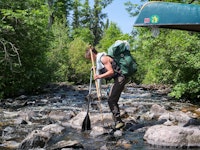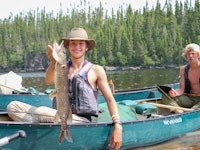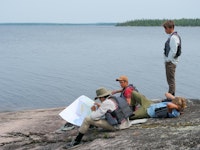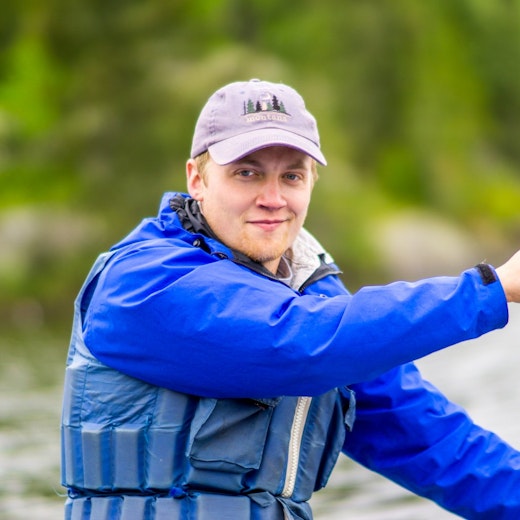By: Jack Casebolt, camper 2021-2024
Shortly after New Year’s in 2024, an anticipated email message arrived stating I’d been invited on the 14-day Wabakimi Canoe Expedition. My excitement filled the room. Eager to see who else was invited, I texted my Camp friend group and discovered that the other campers attending would be Anders Malmberg, Ben Hummel, John “Huck” Ginn, and Peter Harris. Assistant Camp Director Alex Kvanli was slated to lead the canoe expedition and Billy Idol’s Greatest Hits CD would provide the eight-hour soundtrack for the van ride.
Preparation. On the third day of Session 2, we drove two hours south to the University of Minnesota-Duluth St. Louis River Outpost. We met our whitewater canoe instructor, Randy, and his assistant, Sydney, and spent the morning learning river paddling strokes for the bow and stern. After lunch, we paddled to class II rapids and practiced safe swimming techniques, flipping, and rescues. That night, after a quick lesson from Alex about VHSs, we fell asleep in the Outpost to Pirates of the Caribbean.
The next morning we learned how to “find a line,” which means plotting the safest course over rapids via land or water scouting. Randy taught us that it’s not whether you make it down a set, but if you followed the course you plotted. We were dropped off roughly six miles north on the St. Louis River and shot exhilarating rapids back to the Outpost. We practiced communicating amidst the loud whitewater and learned the importance of “eddying out” into the calm areas between each set of rapids. That afternoon we arrived at the final set of daunting class III rapids called Rescue Rapids. We scouted beforehand and all three canoes made it down safely and passed the course!
When we arrived back at Camp Voyageur, we had a lot of canoe modifications to order such as throw bags, helmets, and hardware. We took shifts packing food in pairs as it was a lot to pack for two weeks. I made painter lines for all the boats and rigged up fishing rods for everyone. Anders and Alex installed the hardware on the boats to be “rigged to flip.” The night before departure, we stayed in the Mess Hall until 10:30 poring over our route and figuring out which maps we still needed to pick up in Thunder Bay, Ontario.
Trip Begins. Following our exhilarating departure after breakfast, we flipped on Billy Idol and began the eight-hour drive north to Forest Lodge in northwest Ontario. After being cleared through customs, we stopped in the not-as-interesting-as-we’d-expected town of Thunder Bay to pick up maps at Chaltrek Outdoors. We drove another three hours through the Canadian wilderness until we finally arrived at Forest Lodge on the outskirts of the small quiet town of Armstrong.
The next morning we woke up bright and early and made a quick breakfast before Andre, the operator of Forest Lodge, drove us to the train dropoff. On the way, he tried his best to frighten us with stories of recent bear attacks and how the train ran consistently early, although everything we’d read online said it was notorious for being late. After one last Billy Idol song, we arrived at the train station. As we rigged the canoes with milk jug bailers, p-chord webbing, and throw bags, we heard the “Whaaaaaa! Whaaaaa! Whaa! Whaa!” of the train. We loaded the canoes into the train and boarded the passenger car with dozens of wide-eyed Amish Mennonites.
After an hour ride, we arrived at Allanwater Bridge west of Armstrong in the south end of the Provincial Park. We crossed paddles under the railroad bridge and began down the Allanwater River which flows north, eventually reaching Hudson Bay. While looking for campsites we stumbled across an old decaying trapper’s cabin, where we found a glass piece with a Widjiwagan sticker on it, of all things. Unlike the Boundary Waters, we didn’t need to stay at a designated campsite so we set up camp in a large clearing near the end of a portage. Due to how north we were, it wouldn’t get dark until roughly 11:00 p.m., which took some getting used to.
Nobody set an alarm so we woke up four hours late at 11:00 a.m. the next day, so breakfast was punctuated with sarcastic remarks of being “CV’s finest.” We bushwhacked up some cliffs that afternoon and found the top overtaken by blueberry bushes. We picked blueberries for an hour before settling into a campsite on Brennan Lake.
As day three came around, we cruised across the lake to Brennan Falls and back into the Allanwater River. We found a great campsite and spent the afternoon fishing and swimming.
On day four we set our sights on Wabakimi Lake. That morning we had some of the most pristine paddling conditions I’ve ever experienced. The wide stretch of the river was glass; you could see your reflection like a mirror. Anders and I went first down a set of rapids, though we signaled to the group for them to take the portage. Anders and I shot roughly a half-mile of dodgy rapids. Before each set, we took turns scouting for rocks and ledges, identifying a plan that we both agreed on. We rejoined our group after the portage and finished the rapids together before entering our first big water of the trip. Wabakimi Lake was huge. We could barely see end to end from the middle. Anders and I agreed it seemed way bigger than the humongous Rainy Lake we’d paddled two years ago, even though it wasn’t.
On day five we left the Allanwater River up to Kenoji Lake. We skipped all the portages that day by carefully shooting the rapids. We set up camp early and hunkered down in the tent due to the cold temperature outside.
The following morning we paddled past beautiful topography on both sides of the Ogoki River. We took our first legit unmaintained portage of the trip marked by dozens of trees fallen across the path in every direction. After this portage, we realized we were officially on the path less traveled. As we turned a corner on the meandering Ogoki River, we saw a large dark figure in the water and realized it was a large bull moose. We took some amazing pictures before it bounded back into the thick brush. We paddled into the famous Whitewater Lake and stopped at a fishing lodge to check if they had any fishing line for sale. We met this man called “Buddy” who hooked us up with a free spool of line and two Daredevils for the price of one. He also shared with us his walleye hotspot that we could fish the next day. He told us the same bear story Andre did and said it was years ago, 40 miles north. Buddy’s story differed from Andre’s, but he said he’s heard many versions of that infamous bear story. That night we found an amazing campsite on a massive rock face in a secluded bay and since we were ahead of schedule we decided to duff the next day. We strolled out of the tent at the ripe time of 12:30 p.m. and enjoyed our hot day swimming and tanning because, “The boys are getting tan this summer.” Meanwhile, the largest lake we would paddle on this trip, which had lots of open and exposed areas, was completely glass all day.
Day eight would start by checking out the Ogoki Wilderness Lodge which has been abandoned for almost 20 years! We checked out the maintenance and guest cabins and found newspaper articles from 2005 inside. The main lodge had this very interesting architectural design from a guy named Wendell Beckwith. After exploring the lodge for a few hours, we hit up the walleye hole that Buddy told us about. Alex alone was smokin’ the walleye and the rest of us just got a few, although I caught a 28 ¼” pike which ended up being a plaquer. After dinner, Anders and I cleaned four walleye and devoured a second meal of fresh Canadian fish!
Day nine’s adventure began with a shortcut to cut off five miles on Whitewater Lake. Once on open water, we realized we had our work cut out for us with a stiff headwind. Along the way we spotted a massive black bear only a couple hundred yards away. After lunch, we planned on checking out some other abandoned cabins we’d heard about. We paddled into this inlet bay looking for the cabins. Suddenly, I spotted two deer-looking figures and realized they were woodland caribou! We had dreamed about seeing these as they can be quite rare. We paddled around the corner and found the cabins. As we walked up the beaten path, we saw a sign on the first cabin. It stated that a backwoods scientist, Wendell Beckwith (the same guy who designed Ogoki Wilderness Lodge), had lived here from 1961 until his death in 1980. Everything was left from 1980. The first cabin we explored was known as the Snail due to its interesting design. It was built into a hill, so during winter it wouldn’t take much to heat it. That cabin was like his workshop full of hand tools. Up the path, we found his sleeping cabin that was full of so many little knick-knack designs you would never think of bringing into the wilderness. He had an abundance of National Geographic magazines, the oldest we found dated back to 1971! After we checked everything out, we realized it was too windy to continue paddling so we all took two-hour naps on Wendell’s rock beach before continuing. We pushed through the powerful headwind past a First Nation community and after four days, including one-and-a-half duff days, we were finally off humongous Whitewater Lake. That night we camped on McKinley Lake and ate two dinners, the second consisting of yellow rice and Anders’s three pound summer sausage that he’d bought in Duluth and carried the whole trip, carefully and verbally planning the perfect day to finally eat it. We got so full we felt sick.
Day 10, we went south to Smoothrock. We saw another moose, this time a cow or female moose. We got delayed and had to pull over due to lightning in the area, but after a half hour, we were back on the water. It was a race against time as we had a large storm in the distance moving in on us with just a short distance to go to the campsite. Camp was set up extraordinarily fast as we waited out the storm while Alex cooked us dinner outside in the rain under the tarp. We went outside before bed while it was still sprinkling and saw a truly amazing sunset bursting with vibrant orange and yellow colors.
Day 11 consisted of paddling the Caribou River east. Once again we were delayed by the lightning for an hour, got back on the water, and not even 30 minutes later we had to pull over again. We ate lunch and waited for two hours while it cleared up and pushed through to our campsite right on the edge of the park’s boundary.
Our final day on the water consisted of sleeping in and taking our sweet time eating and packing up before paddling eight miles back to Forest Lodge. Once we arrived, we dragged the canoes onto the sand beach and unpacked. Andre started a sauna for us and in between sauna hits we jumped in the lake and played classic King of the Hill on the lodge’s floating lily pad. We changed into our van clothes and went into the lodge to watch some movies and T.V. Andre and his wife Bridget brought us popcorn and crackers with butter. The next morning we woke up at seven and Andre and Bridget treated us again with a classic Canadian breakfast of hotdogs and beans with croissants. We said our goodbyes and hit the road with Billy Idol blasting. Our last stop after we cleared customs was My Sister’s Place for a victory lunch in Duluth.



Reflections. This trip meant a lot to us all. We had the ambition to do it to the best of our ability safely and without any major incidents. We all spent time over the past years proving ourselves on the trail to earn a spot on this trip. We were the first trip Camp sent up to Wabakimi in 15 years and we were proud to complete the trip as planned and join the small, exclusive club of campers who got to go on an expedition with Camp Voyageur.




